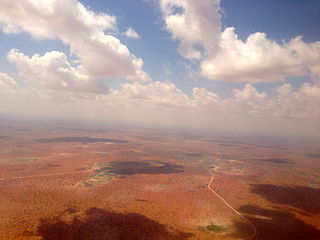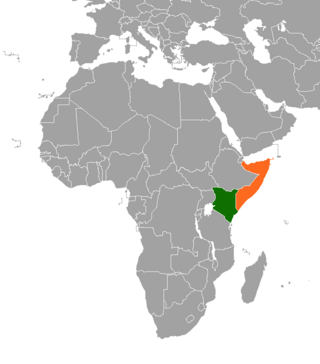
The politics of Kenya take place in a framework of a presidential representative democratic republic, whereby the president is both head of state and head of government, and of a multi-party system in accordance with a new constitution passed in 2010.

Emilio Stanley Mwai Kibaki was a Kenyan politician who served as the third President of Kenya from December 2002 until April 2013.

Stephen Kalonzo Musyoka is a Kenyan politician who was the tenth Vice-President of Kenya from 2008 to 2013. Musyoka served in the government under the late President Daniel arap Moi as the Secretary of Kenya African National Union party (1980-1988), Assistant Minister for Works (1986-1988), Deputy Speaker of the National Assembly (1988-1992), Minister for Foreign Affairs from 1993 until 1998, Minister of Education (1998-2001); and subsequently, under the late President Mwai Kibaki, he was Minister of Foreign Affairs again from 2003 to 2004, then Minister of the Environment from 2004 to 2005. He was an unsuccessful candidate in the 2007 presidential election, after which he was appointed vice-president by Kibaki in January 2008.
The Kenya-Turbi City massacre was the killing of fifty-six people by feuding clans in the remote Marsabit District of Northern Kenya on the early morning of 12 July 2005. Hundreds of armed raiders of the Borana tribe attacked the Gabra people living in the Turbi area northwest of Marsabit. Twenty-two of the sixty confirmed dead were children, and over six thousand people fled their homes, most fleeing to Marsabit town. The massacre's aftermath sparked several violent inter-clan conflicts, raising the death toll to ninety-five.

Raila Amolo Odinga is a Kenyan politician who served as the Prime Minister of Kenya from 2008 to 2013. He was the Member of Parliament (MP) for Langata Constituency from 1992 to 2013 and has been the Leader of Opposition in Kenya since 2013. He is the leader of Azimio la Umoja–One Kenya Coalition Party.

Wajir is the capital of Wajir County of Kenya. It is situated in the former North Eastern Province. The district is primarily inhabited by the Degodia followed by the Ogaden and Ajuran.

Annalena Tonelli was an Italian Catholic lay missionary and social activist. She worked for 33 years in East Africa, where she focused on tuberculosis and HIV/AIDS prevention and treatment, campaigns for eradication of female genital mutilation, and special schools for hearing-impaired, blind and disabled children. In June 2003, Tonelli was awarded the Nansen Refugee Award, which is given annually by the UNHCR to recognize outstanding service to the cause of refugees. In October 2003, she was killed inside her hospital by two gunmen.

Garissa County is an administrative county in Kenya. It is located in Eastern Kenya bordering Somalia to the East, Wajir County and Isiolo County to the North, Tana River County to the West and Lamu County to the South. Its capital and largest urban area is Garissa.
The Shifta War or Gaf Daba (1963–1967) was a secessionist conflict in which ethnic Somalis in the Northern Frontier District (NFD) of Kenya attempted to join Somalia. The Kenyan government named the conflict "shifta", after the Swahili word for "bandit", as part of a propaganda effort. The Kenyan counter-insurgency General Service Units forced civilians into "protected villages" as well as killing livestock kept by the pastoralist Somalis.

General elections were held in Kenya on 27 December 2007. Voters elected the President, and members of the National Assembly. They coincided with the 2007 Kenyan local elections.
The Waki Commission, officially The Commission of Inquiry on Post Election Violence (CIPEV), was an international commission of inquiry established by the Government of Kenya in February 2008 to investigate the clashes in Kenya following the disputed Kenyan presidential election of 2007.
Malka Mari is a settlement in Kenya's Mandera County. Owed to its high concentration of wildlife, Malka Mari National Park was gazetted in the year 1989. The park is situated along the Kenya-Ethiopia border along the Daua River. The river is in the extreme north eastern part of the country on the Mandera plateau. The climate in Malka Mari National Park is hot and dry, implying that the area scrubby and semi arid grassland is dominant. The Daua River is surrounded by palms and riparian woodland.
Kenya's Truth, Justice and Reconciliation Commission (TJRC) was established in 2008. Kenya's modern history has been marked not only by liberation struggles but also by ethnic conflicts, semi-despotic regimes, marginalization and political violence, including the 1982 attempted coup d'état, the Shifta War, and the 2007 post-election violence.

The Somali–Kenyan conflict has been an issue within Kenya since the colonial period. Problems have ranged from skirmishes between the two communities and have led to terrorist attacks, police harassment, extortion, home invasions, physical violence, and massacres perpetrated against Somalis and Kenyans.
The Kenya Presidential Election Petition of 2013 was an election petition aiming to declare the Kenya presidential election 2013 invalid. The Petition was filed at the Supreme Court of Kenya on 16 March 2013.

The presidency of Uhuru Kenyatta began on 9 April 2013 after being sworn in as 4th president of Kenya and ended on 13 September 2022 after handing over to William Ruto. He succeeded Mwai Kibaki. During his inaugural speech Uhuru promised economic transformation by 2030, unity among all Kenyans, free maternal care and that he would serve all Kenyans. In 2017, he won a second term on 8 August and upon a Supreme Court verdict, the results were repealed. The resulting elections were controversial as Raila Odinga boycotted the elections and as the only other active candidate, he won by a 98% victory with the lowest turn out. A stalemate would result as Raila and His partners would carry out a parallel swearing in ceremony after Kenyatta's swearing in. Riots would break out as Raila entered the country resulting in a number of deaths. On 28 March the two partnered to form the Building bridges initiative ending the tense political atmosphere present in the country.
The Kisumu massacre occurred when the presidential guard and police forces shot and killed several civilians in Kisumu Town, the capital of Nyanza Province in Kenya. This took place on 25 October 1969. The official death toll from government sources stands at 11 fatalities but other sources place this number at closer to 100. Victims included women and children, some of whom were shot 30–50 km away from the epicentre of the riots. According to media reports, the government of the day attempted to cover up the extent of the massacre.
On the night of 5–6 July 2014, heavily armed men attacked the Kenyan villages of Hindi in Lamu County and Gamba in Tana River County. At least 29 people were killed in the attacks.
On 2 April 2015, gunmen stormed the Garissa University College in Garissa, Kenya, killing 148 people, and injuring at least 79. The militant groups Al-Qaeda and Al-Shabaab, which the gunmen claimed to belong to, took responsibility for the attack. The gunmen took over 700 students hostage, freeing Muslims and killing those who identified as Christians. The siege ended the same day, when all four of the attackers were killed. Five men were later arrested in connection with the attack, and a bounty was placed for the arrest of a suspected organizer.

The 2018 Kenya handshake was a political truce made on 9 March 2018 between Kenyan President Uhuru Kenyatta and former Kenyan Prime Minister Raila Odinga. The two had been the leaders of opposing political factions amidst widespread political violence and civil unrest; they had previously faced one another in the contested 2017 Kenyan general election. Under the agreement, their political feud with an agreement that Kenyatta would support Odinga in the upcoming presidential elections. Consequently, the Azimio coalition was formed, Uhuru became its chairman, and Odinga became the presidential candidate with Martha Karua as his running mate. They lost to William Ruto, who was then Kenyatta's deputy. They challenged Ruto's victory in the Supreme Court, but Chief Justice Martha Koome said his claims did not meet the evidentiary threshold and dismissed the case. At a March 2023 protest in Nairobi they demanded an audit of the IEBC election servers.










